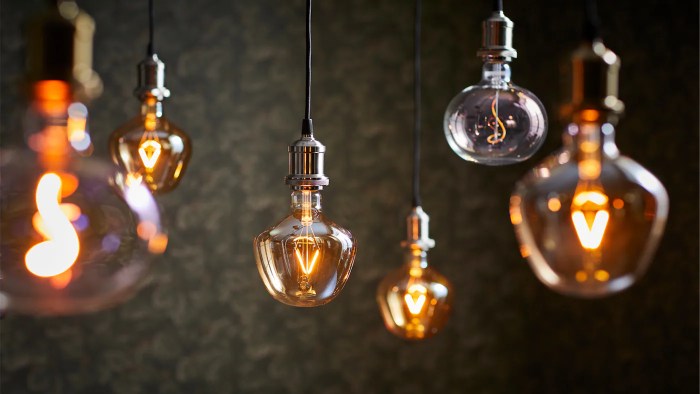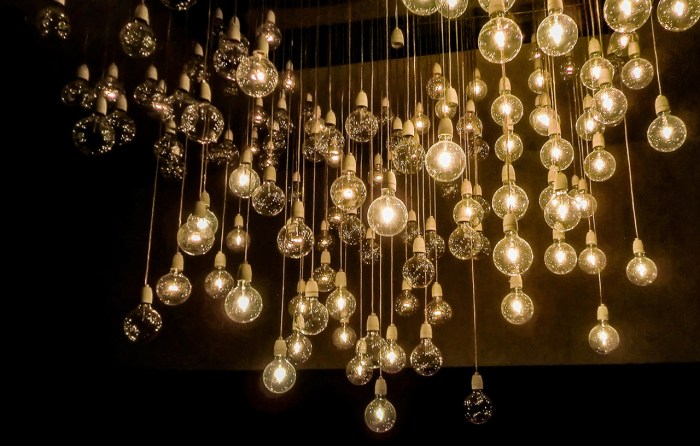Decorative Fixture Bulbs are more than just a source of light; they’re design elements that can dramatically alter the ambiance of any space. From the warm glow of an Edison bulb to the sleek modernity of an LED, the choice of bulb significantly impacts the overall aesthetic. This guide explores the diverse world of decorative bulbs, covering types, styles, applications, and considerations for purchase and installation, empowering you to make informed decisions to illuminate your home with style and efficiency.
We delve into the specifics of various bulb types, including incandescent, LED, halogen, and fluorescent, detailing their advantages and disadvantages regarding energy efficiency, lifespan, and aesthetic appeal. We’ll also explore different shapes and sizes, such as Edison bulbs, globe bulbs, and candle bulbs, showcasing how they complement various interior design themes, from vintage to modern minimalist styles. Understanding bulb technology, including lumens, watts, and color temperature, is key to achieving the desired lighting effect and energy efficiency.
Finally, we’ll provide practical guidance on selecting the right bulb base and safely installing your chosen decorative lighting.
Types of Decorative Fixture Bulbs
Choosing the right bulb for your decorative fixtures can significantly impact the ambiance and overall aesthetic of your space. The market offers a wide variety of options, each with its own strengths and weaknesses regarding energy efficiency, lifespan, and visual appeal. Understanding these differences is crucial for making an informed decision.
Decorative Fixture Bulb Types: A Comparison
The following table provides a detailed comparison of common decorative fixture bulb types: incandescent, LED, halogen, and fluorescent. Consider these factors when selecting bulbs for your specific needs and preferences.
| Bulb Type | Energy Efficiency | Lifespan (Hours) | Aesthetic Appeal | Shapes and Sizes |
|---|---|---|---|---|
| Incandescent | Low; produces significant heat | 750-2000 | Warm, soft light; classic look | Edison bulbs, globe bulbs, candle bulbs, various sizes and shapes |
| LED | High; significantly less heat | 25000-50000+ | Wide range of color temperatures and brightness levels; modern look | Edison bulbs, globe bulbs, candle bulbs, many unique shapes and sizes, including filament-style LEDs that mimic incandescent aesthetics |
| Halogen | Moderate; produces some heat | 2000-4000 | Bright, crisp light; similar to incandescent | Similar shapes and sizes to incandescent bulbs, often smaller and more compact options |
| Fluorescent (Compact Fluorescent Lamps – CFLs) | Moderate; less heat than incandescent | 8000-10000 | Can produce a cool or warm light; less aesthetically pleasing than other options | Typically smaller and more compact than incandescent bulbs; less variety in shapes and sizes |
Incandescent Bulbs: Characteristics and Considerations
Incandescent bulbs are known for their warm, inviting light. Their relatively short lifespan and low energy efficiency are drawbacks, but their classic aesthetic appeal remains popular. Common shapes include Edison bulbs, characterized by their exposed filament, globe bulbs, offering a spherical shape, and candle bulbs, designed to resemble traditional candles. The warm, yellowish light emitted by incandescent bulbs creates a cozy atmosphere, making them suitable for living rooms, bedrooms, and dining areas.
However, their high energy consumption makes them less environmentally friendly and more expensive to operate in the long run.
LED Bulbs: Energy Efficiency and Versatility
LED bulbs are the most energy-efficient option, boasting significantly longer lifespans than incandescent or halogen bulbs. They are available in a vast array of shapes, sizes, and color temperatures, allowing for versatile design choices. LEDs offer a modern aesthetic and can mimic the warm glow of incandescent bulbs with filament-style designs, or provide a brighter, cooler light depending on the application.
For example, a warm-white LED bulb might be perfect for a bedroom, while a cool-white LED could be more suitable for a kitchen or bathroom. Their longevity translates to reduced replacement costs and less environmental impact.
Halogen Bulbs: A Balance of Aesthetics and Efficiency, Decorative Fixture Bulbs
Halogen bulbs offer a compromise between the aesthetic appeal of incandescent bulbs and the energy efficiency of LEDs. While not as energy-efficient as LEDs, they produce a brighter, crisper light than incandescent bulbs and have a longer lifespan. Halogen bulbs are available in similar shapes and sizes to incandescent bulbs, providing design flexibility. However, they still generate more heat than LEDs and have a shorter lifespan than LEDs.
Their use is becoming less common due to the rise of energy-efficient alternatives.
Fluorescent Bulbs (CFLs): Energy Savings and Limitations
Compact Fluorescent Lamps (CFLs) offer better energy efficiency than incandescent bulbs but are less efficient than LEDs. They have a longer lifespan than incandescent bulbs but shorter than LEDs. Their light output can be cool or warm, depending on the type, but they generally lack the aesthetic appeal of incandescent or LED options. The shape and size variety is limited compared to incandescent and LED bulbs.
While CFLs offer some energy savings, the prevalence of more efficient and aesthetically pleasing LEDs has reduced their popularity for decorative fixtures.
Applications and Uses of Decorative Fixture Bulbs

Decorative fixture bulbs transcend mere illumination; they serve as crucial design elements, shaping the atmosphere and aesthetic of a space. The strategic selection of bulb type, color temperature, and brightness level significantly impacts the overall mood and functionality of a room. Understanding these factors allows for the creation of personalized and inviting environments.
Interior Space Applications and Suitable Bulb Types
The choice of decorative bulb is heavily influenced by the intended environment. Different spaces benefit from distinct characteristics in terms of light output, color, and style. Consider these five common interior spaces and their corresponding bulb suggestions:
- Living Rooms: Living rooms often benefit from a warm and inviting ambiance. Warm white (2700-3000K) filament-style LED bulbs or Edison bulbs, known for their vintage aesthetic, create a cozy atmosphere. Higher lumen outputs (800-1200 lumens) provide ample brightness for socializing and relaxation.
- Dining Rooms: Dining rooms require brighter illumination to enhance visibility and create a more formal setting. Cool white (5000-6500K) LED bulbs or halogen bulbs offer a crisp, clean light that complements the dining experience. Higher lumen outputs (1000-1500 lumens) are typically preferred.
- Bedrooms: Bedrooms prioritize a relaxing and calming environment. Dimmable warm white (2700-3000K) LED bulbs are ideal, allowing for adjustable brightness levels to suit different moods and activities. Lower lumen outputs (400-600 lumens) are generally sufficient.
- Bathrooms: Bathrooms benefit from bright, clear illumination for tasks like grooming and makeup application. Daylight (5000-6500K) LED bulbs provide a true-to-life color rendering, ensuring accurate color perception. Moderate lumen outputs (600-800 lumens) are typically sufficient.
- Kitchens: Kitchens require a balance of functionality and ambiance. Cool white (4000-5000K) LED bulbs offer a bright, functional light for food preparation, while warmer accents can be incorporated in pendant lights or under-cabinet lighting for a more inviting atmosphere. Lumen output should be tailored to the size of the kitchen and task lighting needs, ranging from 800-1500 lumens.
Impact of Bulb Color Temperature on Ambiance
Color temperature, measured in Kelvin (K), significantly impacts the perceived ambiance of a room. Warm white (2700-3000K) bulbs emit a yellowish light, creating a cozy and inviting atmosphere, often associated with relaxation and comfort. Cool white (5000-6500K) bulbs, conversely, produce a bluish light, lending a more modern and energizing feel, suitable for task-oriented spaces. Daylight (5000-6500K) bulbs offer a bright, neutral light that accurately reflects colors, ideal for spaces where accurate color perception is crucial.
Influence of Bulb Brightness Levels on Mood and Functionality
Bulb brightness, measured in lumens (lm), directly affects the functionality and mood of a space. Higher lumen outputs provide brighter illumination, ideal for task-oriented areas like kitchens and bathrooms. Lower lumen outputs create a softer, more intimate atmosphere, suitable for living rooms and bedrooms. For instance, a 600-lumen bulb might be sufficient for a bedside lamp, while a 1200-lumen bulb would be better suited for a kitchen’s main lighting.
The appropriate lumen level depends on the size of the room and the desired level of brightness. Consider using dimmable bulbs to adjust brightness according to the time of day or activity.
Bulb Technology and Energy Efficiency

Choosing the right decorative bulb involves understanding the interplay between energy consumption, lifespan, and light output. Different technologies offer varying levels of efficiency and environmental impact, influencing both your electricity bill and your carbon footprint. This section compares and contrasts the performance of LED, incandescent, and halogen bulbs, highlighting key factors to consider when making your selection.
Energy efficiency in lighting is primarily determined by the relationship between energy input (measured in watts) and light output (measured in lumens). Understanding these metrics, along with color temperature, is crucial for making informed decisions. The environmental impact is further considered by examining the manufacturing processes, lifespan, and end-of-life disposal of each bulb type.
Comparison of LED, Incandescent, and Halogen Bulbs
The following table provides a comparative analysis of LED, incandescent, and halogen decorative bulbs, focusing on energy consumption, lifespan, and typical wattage for equivalent light output. Note that values can vary slightly depending on the specific manufacturer and model.
| Feature | LED | Incandescent | Halogen |
|---|---|---|---|
| Energy Consumption (Watts for equivalent light output) | ~6-10W | ~60W | ~50W |
| Lifespan (Hours) | 25,000 – 50,000+ | 750 – 2,000 | 2,000 – 4,000 |
| Energy Efficiency | High (80-90% light, 10-20% heat) | Low (only 10% light, 90% heat) | Moderate (around 20% heat) |
The Role of Lumens, Watts, and Color Temperature
Lumens (lm), watts (W), and color temperature (Kelvin, K) are key parameters to consider when evaluating a bulb’s energy efficiency and light output. Understanding their interrelationship helps optimize lighting choices for both energy savings and desired ambiance.
Lumens quantify the total amount of visible light emitted by a bulb. Watts represent the amount of electrical power consumed. A higher lumen output per watt indicates greater energy efficiency. Color temperature describes the appearance of the light, ranging from warm white (2700K) to cool white (5000K) or daylight (6500K). Lower color temperatures produce a warmer, more yellowish light, while higher temperatures yield a cooler, bluer light.
For example, a 60W incandescent bulb might produce around 800 lumens, while an LED bulb using only 8W can achieve the same light output.
Environmental Impact of Different Bulb Types
The environmental impact of different bulb types stems from energy consumption during use, manufacturing processes, and waste generation at the end of their lifespan. Incandescent bulbs, with their short lifespan and low energy efficiency, contribute significantly to higher energy consumption and greenhouse gas emissions. Halogen bulbs, while more efficient than incandescent, still have a relatively shorter lifespan and generate heat.
LEDs, with their long lifespan and high energy efficiency, significantly reduce energy consumption and greenhouse gas emissions over their lifetime. However, the manufacturing process of LEDs involves rare earth materials, requiring careful consideration of the overall environmental impact across their lifecycle. Responsible recycling programs for all bulb types are crucial to minimize environmental damage from hazardous materials.
Ultimately, selecting the perfect decorative fixture bulb involves a careful consideration of aesthetics, functionality, and energy efficiency. By understanding the nuances of different bulb types, styles, and technologies, you can transform your living spaces with thoughtfully chosen lighting. This guide serves as a comprehensive resource, empowering you to create a beautifully lit and energy-efficient home environment that reflects your unique style and preferences.
Remember to always prioritize safety during installation and replacement.